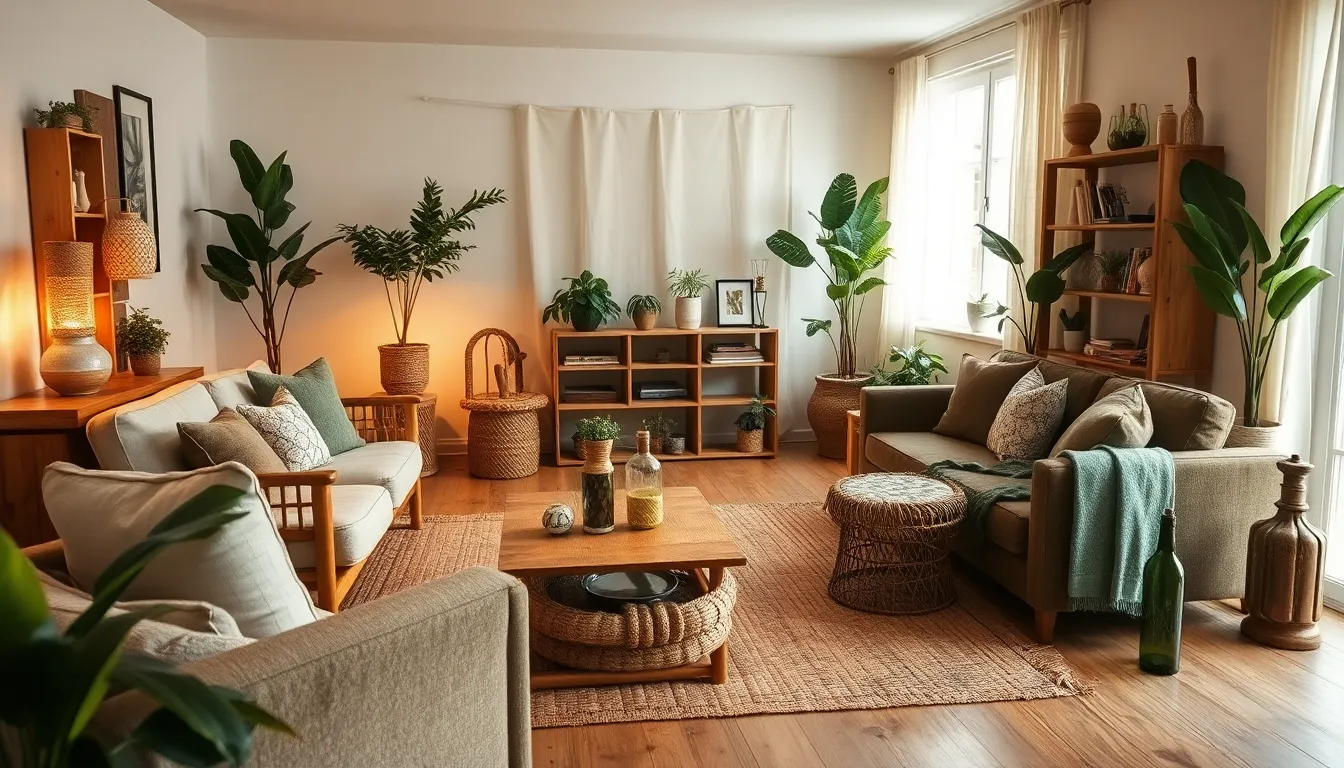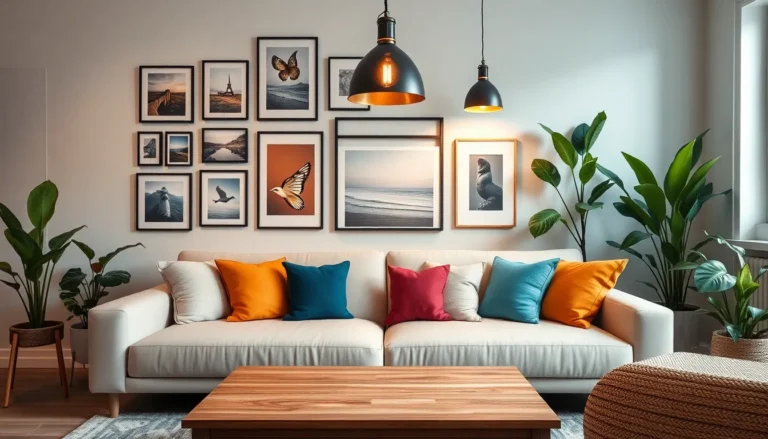In a world where the planet is giving us side-eye for our decor choices, sustainable decor trends are stepping in as the eco-friendly heroes we didn’t know we needed. Imagine turning your living space into a sanctuary that not only looks fabulous but also helps save the Earth. It’s like giving Mother Nature a high-five while sipping your organic herbal tea.
Table of Contents
ToggleOverview of Sustainable Decor Trends
Sustainable decor trends focus on eco-friendly materials and practices. Natural materials like bamboo, cork, and reclaimed wood play a significant role in modern designs. These materials not only reduce environmental impact but also enhance the aesthetics of living spaces.
Biophilic design elements integrate nature into interiors, fostering a connection to the environment. Incorporating plants, green walls, and natural light enhances air quality and mental well-being.
Minimalism continues to influence sustainable decor, emphasizing functionality and reducing waste. Simple, multi-purpose furniture helps create clutter-free spaces, promoting a serene atmosphere.
Local craftsmanship gains recognition for its role in sustainable design. Supporting local artisans reduces carbon footprints associated with shipping and encourages unique, handmade items.
Recycling and upcycling contribute to decor trends, turning waste into stylish pieces. Furniture made from reclaimed materials or repurposed decor items reflects creativity and sustainability.
Energy-efficient lighting options, such as LED bulbs, complement these trends by conserving electricity. Smart home technologies also promote sustainability, allowing for better energy management.
Color palettes lean towards earthy tones, instilling a sense of calm and connection to nature. These hues create inviting environments, contributing to overall mental well-being.
Lastly, textiles made from organic or recycled materials gain traction. Cotton, linen, and wool offer sustainable alternatives while enhancing comfort and style.
Adopting these trends leads to aesthetically pleasing spaces that prioritize sustainability.
Popular Materials in Sustainable Decor

Sustainable decor increasingly utilizes materials that minimize environmental impact. The focus remains on selections that enhance aesthetics while promoting eco-friendliness.
Bamboo and Natural Fibers
Bamboo stands out due to its rapid growth and renewable nature. This material’s strength and versatility make it an excellent choice for furniture and flooring. Natural fibers such as cotton, jute, and linen offer additional options. These fibers come from sustainable sources and biodegrade easily. Their softness and texture contribute to comfortable spaces. The combination of bamboo and natural fibers creates a warm and inviting atmosphere that aligns with eco-conscious living.
Recycled and Repurposed Materials
Recycled materials play a critical role in sustainable decor. Items like reclaimed wood and recycled metal significantly reduce waste and energy usage. Artisans often transform these materials into unique furniture and decor pieces, illustrating creativity and sustainability. Repurposed objects, such as glass bottles or old textiles, can breathe new life into home decor. By choosing recycled and repurposed materials, it’s possible to create distinctive designs that minimize environmental footprints and promote a circular economy.
Color Palettes and Design Aesthetics
Sustainable decor trends favor color palettes that evoke nature’s beauty. Earthy tones and natural neutrals dominate, enhancing a sense of calm and connection to the environment.
Earthy Tones and Neutrals
Earthy tones such as terracotta, sage green, and soft browns create a grounding atmosphere in living spaces. Neutrals like beige and cream act as a backdrop for natural materials and textures, ensuring versatile design. These colors harmonize well with organic elements, allowing furnishings to stand out without overwhelming the senses. Homeowners often choose these shades to promote tranquility and warmth, fostering inviting environments. Implementing these palettes encourages a relaxed ambiance while remaining mindful of sustainability, reflecting a commitment to eco-friendly choices.
Biophilic Design Elements
Biophilic design elements bring nature indoors, enhancing well-being while highlighting sustainable principles. Incorporating plants, natural light, and organic shapes promotes a visual connection to the outdoors, improving air quality and mental health. Living walls or indoor gardens add greenery while utilizing space creatively. Natural light, emphasized through large windows or skylights, reduces the need for artificial lighting and brightens interiors. Artisans curate decor pieces using materials that reflect nature’s forms, from furniture to accessories. These elements create an atmosphere that nurtures harmony with the environment, merging aesthetics with eco-conscious living.
Innovative Brands Leading the Way
Many innovative brands focus on sustainable decor, offering stylish solutions that prioritize environmental responsibility.
Ethical Furniture Companies
Several furniture companies stand out for their commitment to sustainability. West Elm sources materials responsibly while supporting artisans worldwide. Pottery Barn features a range of eco-friendly furniture, crafted from reclaimed wood and sustainable materials. Another noteworthy brand, Joybird, uses recycled foam and sustainable woods, ensuring minimal environmental impact during production. These companies prove that ethical practices can blend with beautiful design, making eco-conscious choices accessible.
Eco-friendly Home Accessories
Numerous brands specialize in eco-friendly home accessories, enhancing decor while promoting sustainability. Made Trade offers a curated selection of ethically made home goods, from organic cotton throws to handwoven rugs. Similarly, EarthHero emphasizes a zero-waste philosophy with products like bamboo kitchen items and compostable dishware. Greenhouse Eco Clean provides natural cleaning supplies that keep homes safe and healthy. Each brand contributes to creating inviting spaces while supporting a sustainable lifestyle.
The Impact of Sustainable Decor on Wellbeing
Sustainable decor significantly enhances personal well-being through its connection to nature. Biophilic design elements such as plants and natural light improve air quality, fostering a calming environment. Incorporating natural materials like bamboo and reclaimed wood creates inviting spaces, elevating mood and reducing stress.
Natural fibers including jute and linen contribute comfort, influencing overall mental health positively. A simple, minimalist approach reduces clutter and promotes a feeling of tranquility. Although multifunctional furniture saves space, it also encourages a more organized lifestyle.
Energy-efficient lighting not only conserves resources but also generates a warm, welcoming atmosphere. Color palettes featuring earthy tones like terracotta and sage green evoke feelings of peace and harmony. Neutrals in home decor provide a versatile backdrop, accommodating various design preferences while enhancing relaxation.
In addition, local craftsmanship supports artisans and reinforces community ties, creating a sense of belonging and security in living spaces. Each unique piece tells a story, imbued with the values of sustainability. Upcycled materials offer innovative decor solutions, showcasing creativity and environmental responsibility.
Living walls and strategically placed windows harness sunlight, reducing reliance on artificial lighting and connecting individuals to the outdoor environment. Such features not only brighten spaces but also elevate moods, providing a daily reminder of nature’s beauty.
Overall, sustainable decor practices lead to aesthetically pleasing environments that nurture mental and emotional well-being. Prioritizing these elements fosters a lifestyle committed to both personal health and environmental sustainability.
Embracing sustainable decor trends not only enhances living spaces but also nurtures a deeper connection to the environment. By prioritizing eco-friendly materials and practices, individuals can create beautiful homes that reflect their commitment to the planet.
Incorporating biophilic design elements and minimalist approaches fosters tranquility and well-being, allowing for a harmonious balance between aesthetics and sustainability. Supporting local artisans and utilizing recycled materials adds a unique touch while promoting a circular economy.
As innovative brands continue to lead the charge in ethical design, making sustainable choices has never been easier. Adopting these trends contributes to a healthier lifestyle and a more sustainable future, proving that style and responsibility can go hand in hand.






